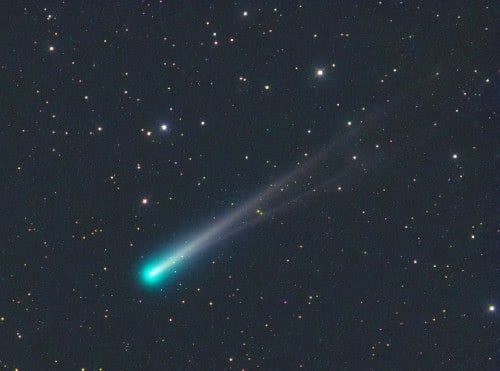Comet ISON has already crossed the Earth's orbit and is rapidly plunging towards the Sun for a close and fiery encounter on November 28. Will it disintegrate on the way there, will it burn up or perhaps survive in one way or another and become a bright comet visible to the naked eye? From the point of view of a scientist engaged in comet research on behalf of NASA, all possibilities are open and amazing

Comet ISON has already crossed Earth's orbit and is rapidly plunging toward the Sun for a close and fiery encounter on November 28. Although the comet is not yet as bright as the astronomers predicted, it is already in the observation program all over the world and outside of it. NASA spacecraft all over the solar system and amateur astronomers alike are taking sharp pictures of the comet's thin green atmosphere and its double tail.
Because Ison has never visited the inner solar system (this is his first visit from the distant Oort cloud). The experts are not sure what will happen next. Will the comet survive its encounter with the sun, will it be bright enough to be visible to observers with the naked eye? Matthew Knight, an astronomer at the Lovell Observatory and a member of NASA's Comet ISON observation campaign explains some of the possibilities.
"I grouped the possible outcomes into three scenarios," says Knight. "It is important to note that no matter what happens, all these scenarios are exciting from a scientific point of view. We're going to learn a lot, no matter what."
Scenario 1: Spontaneous disintegration by the end of November
The first scenario, which can happen at any time, is that ISON spontaneously disintegrates. A small part (less than 1%) of the comets disintegrate for no apparent reason. Recent examples include Comet LINEAR (C/1999 S4 in 2000 and Comet Elenin (C/2010 X1 in 2011). ISON now reaches the region within 0.8 AU where these comets collapsed.
Comet Ison is watched by astronomers using a huge variety of telescopes on Earth and beyond. If it disintegrates it will be the largest recorded case of cometary disintegration and could contribute enormous new information about how comets die.
Scenario 2: Death from sunburn
Assuming Iason survives the next few weeks unscathed, he faces an even more daunting challenge: the sun's coffee at its closest point. The comet's temperature will reach 5000 degrees Celsius, hot enough to cause much of the dust and rock on Ison's surface to vaporize.
Although the possibility that anything at all could survive this inferno might be incredible, the rate at which Ison would lose mass would be small relative to the enormous size of the comet's nucleus. Ison needs a width of 200 meters to survive. Current estimates speak of between 500 meters and 2 kilometers. This will help him move fast enough to not stay long enough in these extreme heat conditions.
Although it may seem incredible, because anything can survive this inferno, the rate at which Ison is expected to lose mass is relatively small compared to the actual size of the comet's nucleus. Ison needs a width of 200 m to survive; Current estimates range from 500 meters to 2 kilometers. The comet moves very fast so it will not stay long in such extreme temperatures. Unfortunately for Iason, he faces a double trap due to his proximity to the sun. Even if it survives the rapid evaporation of its exterior, it may get close enough to the Sun for its gravity to tear it apart.
The destroyed comet may still be impressive to watch. The solar comet Labjoy, for example, passed about 160 km from the surface of the Sun in 2011. It disintegrated and created a long tail of dust that amazed observers on Earth.
Scenario 3: Survival
The last possibility is extremely simple: Ison survives its collision with the Sun and exits it with enough of a hole in the nucleus to continue to be an active comet. If the comet survives the transit it is expected to lose enough dust near the Sun to produce a nice tail. In the best case scenario, in a realistic scenario, the tail will stretch tens of degrees and light up the early morning sky like Comet McNaught (McNaught C/2006 P1) in 2007.
The best of all possible worlds would be if Iason disintegrated just a little, say into several large pieces. It will be able to eject enough material to become a bright comet and be visible from the ground, allowing astronomers to study the comet fragments for many months. "I'm definitely in favor of scenario 3," says Knight.
"No matter what happens, we are going to be happy", he predicts. "Astronomers are getting an opportunity to study a unique comet that arrives after 4.5 billion years of deep freezing into a close encounter with the sun's furnace and will be observed using the largest array of telescopes in history." We'll wait and see, we're just at the beginning.
For updates and more information about Comet ISON's approach to the Sun

6 תגובות
The article was published yesterday on the SCIENCE AT NASA website
The article is probably not from the next few days
Because now the comet stands at 0.6 and has passed the distance of the circumference of the planet Venus
And a speed over 50 kilometers per second, the brightness of the 8- to 12-year-old comet changes
you are welcome!! Requires linguistic editing: Lachach, not Lachach, a paragraph repeated twice almost without change. It's just a shame - significantly harms the feeling of quality of the site.